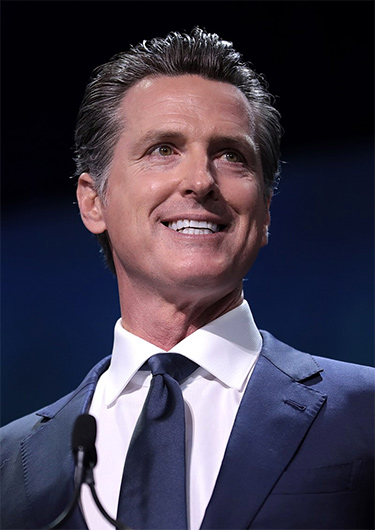By Jim Ellis
March 17, 2021 — Just days before reaching the recall petition deadline, Emerson College for the Nextar Media Group, an entity that owns several news stations throughout California, conducted a poll regarding the respondents’ predispositions about removing Gov. Gavin Newsom (D) from office.The poll, conducted March 12-14 of 1,045 registered Golden State voters, finds Gov. Newsom’s position becoming more tenuous as the recall organizers prepare to deliver the last of their petitions today that will likely lead to a removal election.
It appears the proponents have a strong chance of qualifying. Last week, they reported gathering 2.055 million signatures. The minimum number of valid signatures to force an election is 1,495,709, which represents 12 percent of the total number of people voting in the preceding gubernatorial election, 2018 in this case. The organizers say they can withstand a 25 percent rejection rate and still qualify the recall. Of the signatures so far delivered and checked, the acceptance rate is 82 percent, far above the minimum needed to qualify.
According to the Emerson poll, the gap between those who would vote to retain Gov. Newsom and remove him has narrowed. Emerson found 42 percent of the respondents expressing a preference against recalling Gov. Newsom, while 38 percent favor doing so.
One year ago (March 17-18, 2020), 52 percent in a Remington Research Group poll said they would oppose recalling the governor with just 31 percent saying they would vote for removal from office. The University of California at Berkeley in late January of this year, found a 49-36 percent split in favor of retaining the governor. In February, however, a WPA Intelligence survey saw the retain lead dwindling to 47-43 percent. Now, Emerson College posts its 42-38 percent number.
Perhaps the more daunting part of the Emerson poll for Gov. Newsom was the 2022 re-elect question. Here, only 42 percent said they wanted to see him re-elected as opposed to 58 percent indicating they prefer someone different.
On the positive note for the governor, his overall job approval rating is still in positive territory, but just barely (45:44 percent); yet even better, a substantial margin of the sampling universe, 57-43 percent, believe California is on the right track.
Segmenting the responses, it is not surprising to find that the vast majority of those wanting to recall the governor are Republicans. In fact, 86 percent of the sampled Republicans are supportive of removing the incumbent. A total of 39 percent of Independents agree, as well as 12 percent of Democrats.
On the other end of the spectrum, 66 percent of Democrats would vote to retain, as would 34 percent of Independents, but just 6 percent of Republicans.
Another negative for Newsom is the tested voter turnout model. Of those saying they are not inclined to vote in the impending special recall election, less than one percent are Republicans, suggesting intensity for this election is extremely high within the state’s minority party. A total of six percent of Democrats and ten percent of Independents also say they are not inclined to participate, both relatively bad numbers for Gov. Newsom.
Another advantage the governor will have in this election is that the fundraising limits are not in effect for recall elections. That means, the candidates can raise as much as they want from individuals and qualified committees. This situation will clearly favor the Newsom fundraising machine.
Additionally, it will be the incumbent’s allies who will have the power to schedule the recall once certified. The process goes to the legislature and then to Democratic Lt. Gov. Eleni Kounalakis who has the final scheduling authority.
The lieutenant governor will have a large timing leeway in terms of when the vote is scheduled. Some discussion is emerging that she could attempt to have the legislature move the regular June primary to March, and then schedule the removal election concurrently with the regular 2022 jungle primary. Waiting almost a year from qualification could have an effect that the Democrats don’t desire, however, as the recall proponents will be infuriated with such a long delay from the time millions of voters signed the recall petitions.
At this point, it appears Gov. Newsom is positioned well enough to survive a recall, but should a strong Democrat enter the replacement election, his prospects could rapidly decline. The Newsom recall is already providing a glimpse that this will be quite an interesting electoral procedure.

